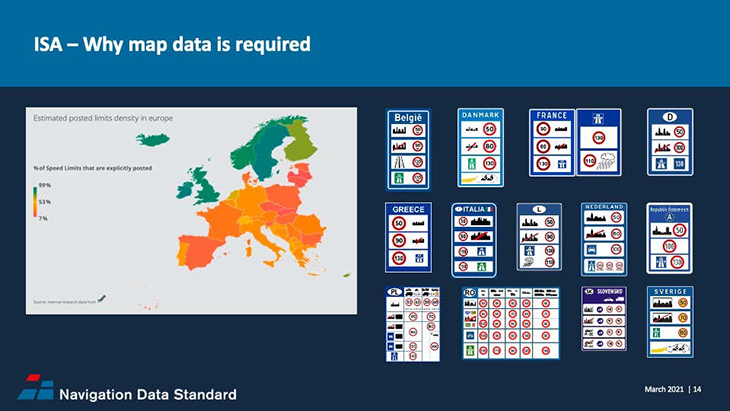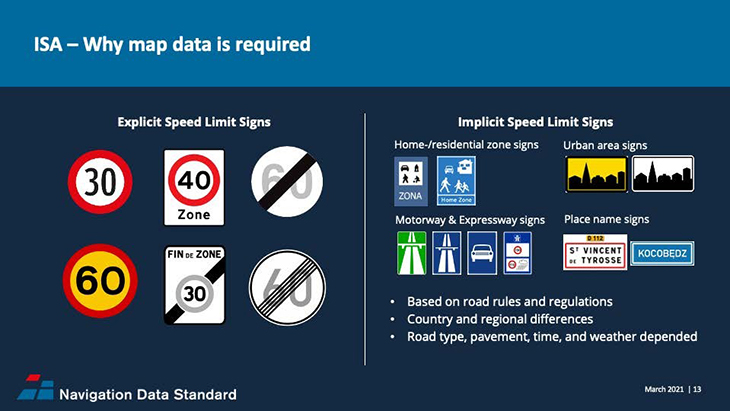The European Commission has set up a Road Safety Group, whose members proposed the concept of “Vision Zero”. Its aim is to reduce road deaths to zero or as close to it as possible by 2050.
Speed limit violations are a prominent cause of fatal crashes on roads around the world. According to the USA’s National Highway Transportation Safety Administration (NHTSA), speeding remains the number one factor in more than 25 percent of fatal accidents each year, making it the biggest cause of fatal accidents in the United States. The corresponding EU figures are similar. In Germany with its comparatively high traffic density, it is even higher: One in three traffic deaths can be attributed to speeding. “Speed”, summarizes the European Transport Safety Council (ETSC), “is the number one killer on Europe’s roads.”
Intelligent Speed Assistance (ISA) is one measure in a set of policies and legislative initiatives which are implemented to reduce traffic fatalities and has, according to an ETSC estimate, the potential to cut road deaths by 20%.
Intelligent Speed Assistance is an in-vehicle system designed to assist drivers in complying with speed limits. It will be implemented in two stages and becomes mandatory for new types of cars, vans, trucks, and buses starting in July 2022, and for all newly registered vehicles from July 2024 onwards. In addition to the 27 EU member countries, Norway, Switzerland, and the UK, as well as selected EU candidate countries, have signaled that that they will adopt the ISA Regulation into national law.
For OEMs, this means, of course, an obligation to comply with the directive to meet the approval requirement for their vehicles for the European market. The ISA regulation defines a 90% target to correctly recognize and, depending on the system, apply legal speed limits. An ISA system has to display the legal speed limit to the driver at all times. That is the minimum requirement by the regulation. It may also acoustically or visually alert the driver when exceeding the speed limit, as some navigation systems already do. In combination with ADAS features, an ISA implementation may also intervene more actively by not accepting acceleration once the speed limit is reached, or by automatically adjusting the speed when a cruise control system is active.
Whether passive or active, ISA affects the driving experience, and inaccuracies and malfunctions will translate directly into customer dissatisfaction. If speed limits displayed or applied are not concurrent with the actual ones, this may result in time lost or speeding tickets.
The NDS Association members are convinced map data is beneficial for ISA solutions, because not all speed limits are detectable by a camera-only system. And that is because not all speed limits are sign-posted. For example:

Even the speed limits that are clearly “announced” on signposts may be hard to read, obscured by snow, buildings, trees, or other vehicles, or a normally valid speed limit may be altered due to construction works. Speed limits sometimes have much smaller, conditional sub-signs that are challenging to read for camera systems. For OEMs it is important to note that these conditional speed limits are not part of the regulation’s test criteria. They are, however, part of the driver’s user experience, which brings us back to the problem of dissatisfaction when speed limits are not displayed or applied correctly in the vehicle’s ISA system.
Then there are also speed limits that are not explicitly shown on the sign itself. The following two figures illustrate the issue of explicit vs. implicit speed limits:

The member companies of the NDS Association and many other stakeholders in the automotive industry are convinced that ISA systems will have to use map data to meet the EU’s test approval requirement of a 90 % success rate. This level of accuracy would be impossible to obtain when relying exclusively on a camera-based system. In the absence of signs, fresh, reliable map data is the only trustworthy source for speed limits. This is where NDS.Live-based solutions come into play as they provide the additional benefit of regular and seamless updates and can help to minimize data consumption.
Watch the recordings of the NDS Association webinars “NDS.Live for Intelligent Speed Assistance” and “Reducing data consumption with NDS.Live”
As for data accuracy, we need to bear in mind that speed limits change at an average rate of 10% per year across Europe, and that national regulations can change, as they did in France and The Netherlands in 2019. A satisfactory user experience is therefore conditional upon accurate, reliable, and – in this case quite literally – up-to-speed map data.
Back to news →